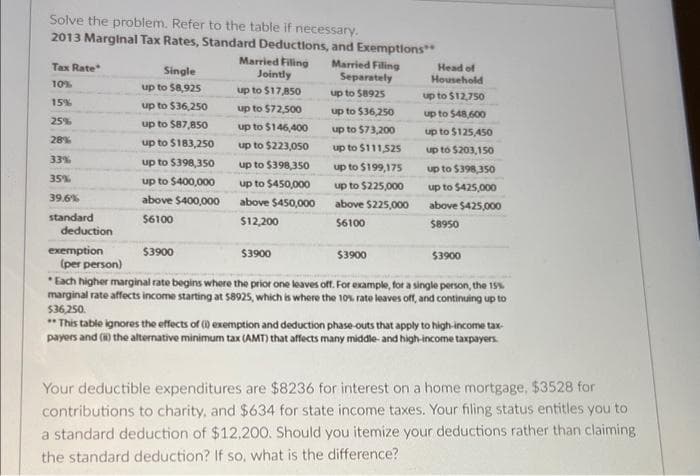Solve the problem. Refer to the table if necessary. 2013 Marginal Tax Rates, Standard Deductions, and Exemptions** Married Filing Jointly Married Filing Separately up to $17,850 to 58925 Tax Rate 10% 15% 25% 28% 33% 35% 39.6% standard deduction exemption (per person) Single up to $8,925 up to $36,250 up to $87,850 up to $183,250 up to $398,350 up to $400,000 above $400,000 $6100 $3900 up to $72,500 up to $146,400 up to $223,050 up to $398,350 up to $450,000 above $450,000 $12,200 $3900 up up to $36,250 up to $73,200 up to $111,525 up to $199,175 up to $225,000 above $225,000 $6100 $3900 Head of Household up to $12,750 up to $48,600 up to $125,450 up to $203,150 up to $398,350 up to $425,000 above $425,000 $8950 $3900 Each higher marginal rate begins where the prior one leaves off. For example, for a single person, the 15% marginal rate affects income starting at $8925, which is where the 10% rate leaves off, and continuing up to $36,250. **This table ignores the effects of () exemption and deduction phase-outs that apply to high-income tax- payers and (i) the alternative minimum tax (AMT) that affects many middle and high-income taxpayers. Your deductible expenditures are $8236 for interest on a home mortgage, $3528 for contributions to charity, and $634 for state income taxes. Your filing status entitles you to a standard deduction of $12,200. Should you itemize your deductions rather than claiming the standard deduction? If so, what is the difference?
Solve the problem. Refer to the table if necessary. 2013 Marginal Tax Rates, Standard Deductions, and Exemptions** Married Filing Jointly Married Filing Separately up to $17,850 to 58925 Tax Rate 10% 15% 25% 28% 33% 35% 39.6% standard deduction exemption (per person) Single up to $8,925 up to $36,250 up to $87,850 up to $183,250 up to $398,350 up to $400,000 above $400,000 $6100 $3900 up to $72,500 up to $146,400 up to $223,050 up to $398,350 up to $450,000 above $450,000 $12,200 $3900 up up to $36,250 up to $73,200 up to $111,525 up to $199,175 up to $225,000 above $225,000 $6100 $3900 Head of Household up to $12,750 up to $48,600 up to $125,450 up to $203,150 up to $398,350 up to $425,000 above $425,000 $8950 $3900 Each higher marginal rate begins where the prior one leaves off. For example, for a single person, the 15% marginal rate affects income starting at $8925, which is where the 10% rate leaves off, and continuing up to $36,250. **This table ignores the effects of () exemption and deduction phase-outs that apply to high-income tax- payers and (i) the alternative minimum tax (AMT) that affects many middle and high-income taxpayers. Your deductible expenditures are $8236 for interest on a home mortgage, $3528 for contributions to charity, and $634 for state income taxes. Your filing status entitles you to a standard deduction of $12,200. Should you itemize your deductions rather than claiming the standard deduction? If so, what is the difference?
Fundamentals of Financial Management, Concise Edition (MindTap Course List)
9th Edition
ISBN:9781305635937
Author:Eugene F. Brigham, Joel F. Houston
Publisher:Eugene F. Brigham, Joel F. Houston
Chapter3: Financial Statements, Cash Flow, And Taxes
Section: Chapter Questions
Problem 8P: PERSONAL TAXES Susan and Stan Britton are a married couple who file a joint income tax return, where...
Related questions
Question

Transcribed Image Text:Solve the problem. Refer to the table if necessary.
2013 Marginal Tax Rates, Standard Deductions, and Exemptions**
Married Filing
Jointly
Married Filing
Separately
up to $17,850
up to 58925
Tax Rate
10%
15%
25%
28%
33%
35%
39.6%
standard
deduction
exemption
(per person)
Single
up to $8,925
up to $36,250
up to $87,850
up to $183,250
up to $398,350
up to $400,000
above $400,000
$6100
$3900
up to $72,500
up to $146,400
up to $223,050
up to $398,350
up to $450,000
above $450,000
$12,200
$3900
up to $36,250
up to $73,200
up to $111,525
up to $199,175
up to $225,000
above $225,000
$6100
$3900
Head of
Household
up to $12,750
up to $48,600
up to $125,450
up to $203,150
up to $398,350
up to $425,000
above $425,000
$8950
$3900
*Each higher marginal rate begins where the prior one leaves off. For example, for a single person, the 15%
marginal rate affects income starting at $8925, which is where the 10% rate leaves off, and continuing up to
$36,250.
**This table ignores the effects of () exemption and deduction phase-outs that apply to high-income tax-
payers and (ii) the alternative minimum tax (AMT) that affects many middle- and high-income taxpayers.
Your deductible expenditures are $8236 for interest on a home mortgage, $3528 for
contributions to charity, and $634 for state income taxes. Your filing status entitles you to
a standard deduction of $12,200. Should you itemize your deductions rather than claiming
the standard deduction? If so, what is the difference?
Expert Solution
This question has been solved!
Explore an expertly crafted, step-by-step solution for a thorough understanding of key concepts.
Step by step
Solved in 2 steps

Recommended textbooks for you

Fundamentals of Financial Management, Concise Edi…
Finance
ISBN:
9781305635937
Author:
Eugene F. Brigham, Joel F. Houston
Publisher:
Cengage Learning

Fundamentals Of Financial Management, Concise Edi…
Finance
ISBN:
9781337902571
Author:
Eugene F. Brigham, Joel F. Houston
Publisher:
Cengage Learning


Fundamentals of Financial Management, Concise Edi…
Finance
ISBN:
9781305635937
Author:
Eugene F. Brigham, Joel F. Houston
Publisher:
Cengage Learning

Fundamentals Of Financial Management, Concise Edi…
Finance
ISBN:
9781337902571
Author:
Eugene F. Brigham, Joel F. Houston
Publisher:
Cengage Learning



Individual Income Taxes
Accounting
ISBN:
9780357109731
Author:
Hoffman
Publisher:
CENGAGE LEARNING - CONSIGNMENT
